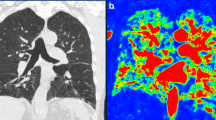Abstract
Nonuniform distribution (NUD) of perfusion on single photon emission computed tomography (SPECT) is caused by impaired perfusion-related fluctuations of the functional volume (FFV). It was determined if digital analysis of NUD in each hemi-lung damaged by chronic obstructive pulmonary disease (COPD) could improve the whole lung impairment assessment. We examined 665 subjects and 8 controls by SPECT. The basic whole lung SPECT volume was defined at 10 % of maximum whole lung count cutoff threshold (T h). For the whole lung and each hemi-lung, the 10 % T h width volume, FFV rate, and misfit from the control were calculated at every T h width number (n) from 1 to 9 for every additional 10 % T h from 10 to 100 %. The misfit value integrated from 1 to 9 of n was defined by 3 NUD indices: D, whole lung NUD index; D rl , the index for the sum of each hemi-lung NUD; and D I, the NUD index with every interpolating pattern in which FFV rates of hemi-lungs comprised negative and positive value at the same n. D rl index was the sum of D and D I indices in all patients. D rl and D indices significantly increased in pulmonary disease subjects relative to those of the normal group and non-pulmonary disease subjects. D rl and D indices increased in COPD subjects. Progressive COPD subjects had larger D rl index values and “diffuse and even” hemi-lung impairment. The three indices quantizing FFV itself leading to NUD helped to digitally evaluate the degree of lung impairment of perfusion. Clinically, it is expected that the NUD indices and images obtained by SPECT, which visually and digitally show the pathological fluctuations in perfusion caused by lung impairment, will be able to provide specific and useful information for improving treatment and/or care of subjects with COPD.





Similar content being viewed by others
References
Carratu L, Salvatore M, Lopez-Majano V, Sofia M, Muto P, Ariemma G. Single photon emission computed tomography study of human pulmonary perfusion: preliminary findings. Nucl Med Commun. 1984;5:91–9.
Petersson J, Sánchez-Crespo A, Larsson SA, Mure M. Physiological imaging of the lung: single-photon-emission computed tomography (SPECT). J Appl Physiol. 2007;102:468–76.
Sostman HD, Miniati M, Gottschalk A, Matta F, Stein PD, Pistolesi M. Sensitivity and specificity of perfusion scintigraphy combined with chest radiography for acute pulmonary embolism in PIOPED II. J Nucl Med. 2008;49:1741–8.
Mitomo O, Aoki S, Tsunoda T, Yamaguchi M, Kuwabara H. Quantitative analysis of nonuniform distributions in lung perfusion scintigraphy. J Nucl Med. 1998;39:1630–5.
Fletcher CM. The clinical diagnosis of pulmonary emphysema; an experimental study. Proc R Soc Med. 1952;45:577–84.
Global Initiative for Chronic Obstructive Lung Disease (GOLD). Global strategy for the diagnosis, management, and prevention of chronic obstructive pulmonary disease (COPD). 2015. http://www.goldcopd.org/guidelines-global-strategy-for-diagnosis-management.html. Accessed 24 Apr 2015.
Kawakami Y, Irie T, Kishi F. Criteria for pulmonary and respiratory failure in COPD patients—a theoretical study based on clinical data. Respiration. 1982;43:436–43.
Wright JL, Levy RD, Churg A. Pulmonary hypertension in chronic obstructive pulmonary disease: current theories of pathogenesis and their implications for treatment. Thorax. 2005;60:605–9.
Mets OM, de Jong PA, van Ginneken B, Gietema HA, Lammers JW. Quantitative computed tomography in COPD: possibilities and limitations. Lung. 2012;190:133–45.
Bajc M, Markstad H, Jarenbäck L, Tufvesson E, Bjermer L, Jögi J. Grading obstructive lung disease using tomographic pulmonary scintigraphy in patients with chronic obstructive pulmonary disease (COPD) and long-term smokers. Ann Nucl Med. 2015;29:91–9.
Glenny RW, Lamm WJ, Bernard SL, An D, Chornuk M, Pool SL, et al. Selected contribution: redistribution of pulmonary perfusion during weightlessness and increased gravity. J Appl Physiol. 2000;89:1239–48.
West JB. Regional differences in the lung. Chest. 1978;74:426–37.
Baumgartner WA Jr, Jaryszak EM, Peterson AJ, Presson RG Jr, Wagner WW Jr. Heterogeneous capillary recruitment among adjoining alveoli. J Appl Physiol. 2003;95:469–76.
Han MK, McLaughlin VV, Criner GJ, Martinez FJ. Pulmonary diseases and the heart. Circulation. 2007;116:2992–3005.
Ingram RH, Szidon JP, Skalak R, Fishman AP. Effects of sympathetic nerve stimulation on the pulmonary arterial tree of the isolated lobe perfused in situ. Circ Res. 1968;22:801–15.
Qureshi A. Diaphragm paralysis. Semin Respir Crit Care Med. 2009;30:315–20.
Esteve JM, Launay JM, Kellermann O, Maroteaux L. Functions of serotonin in hypoxic pulmonary vascular remodeling. Cell Biochem Biophys. 2007;47:33–44.
Palmer RM, Ferrige AG, Moncada S. Nitric oxide release accounts for the biological activity of endothelium-derived relaxing factor. Nature. 1987;327:524–6.
Hsia CC. Signals and mechanisms of compensatory lung growth. J Appl Physiol. 2004;97:1992–8.
Hopkins SR, Wielpütz MO, Kauczor HU. Imaging lung perfusion. J Appl Physiol. 2012;113:328–39.
Acknowledgments
The author thanks the staff of the Department of Radiology, Dr. Hidemasa Kuwabara, Dr. Katsuya Kato (General Ota Hospital, Ota, Japan), Dr. Kiyokazu Arai and the members of the stuff in the Advanced Medical Imaging and Analysis Center (AMIAC, Maebashi, Japan), and Dr. Takayuki Kohri (Tone Chuou Hospital, Numata, Japan) for the examinations. I also thank the staff of Siemens Japan, MI Business Management Dept., for technical assistance during quantification of image data. In addition, I would like to thank Enago (http://www.enago.jp) for the English language review.
Author information
Authors and Affiliations
Corresponding author
Ethics declarations
Conflict of interest
The author has no conflicts of interest.
Rights and permissions
About this article
Cite this article
Mitomo, O. Quantification of nonuniform distribution of hemi-lung perfusion in chronic obstructive pulmonary disease. Ann Nucl Med 30, 3–10 (2016). https://doi.org/10.1007/s12149-015-1043-x
Received:
Accepted:
Published:
Issue Date:
DOI: https://doi.org/10.1007/s12149-015-1043-x




